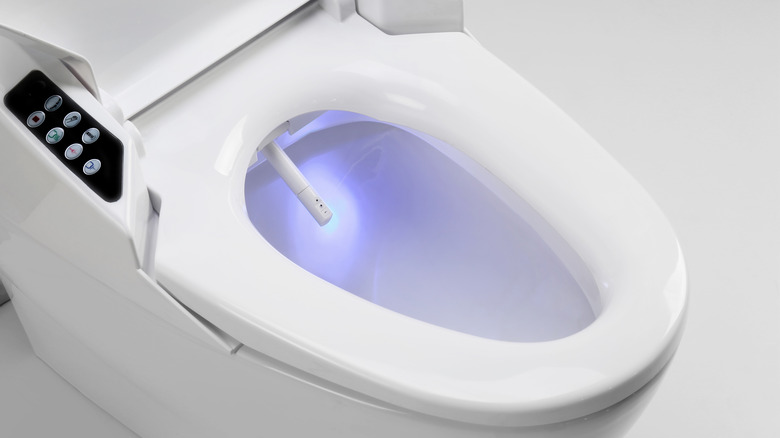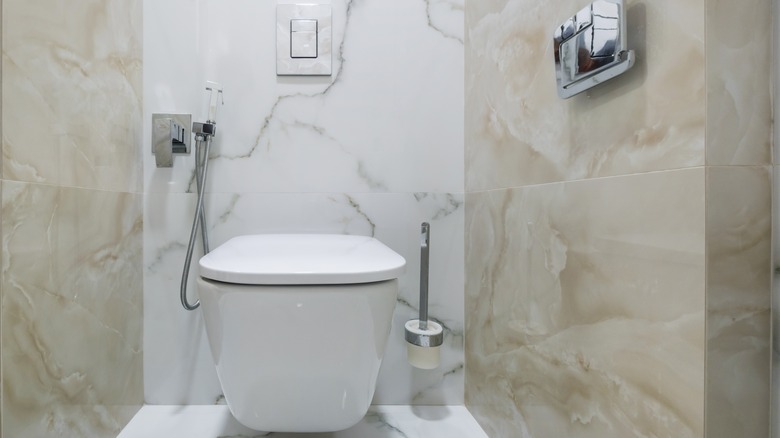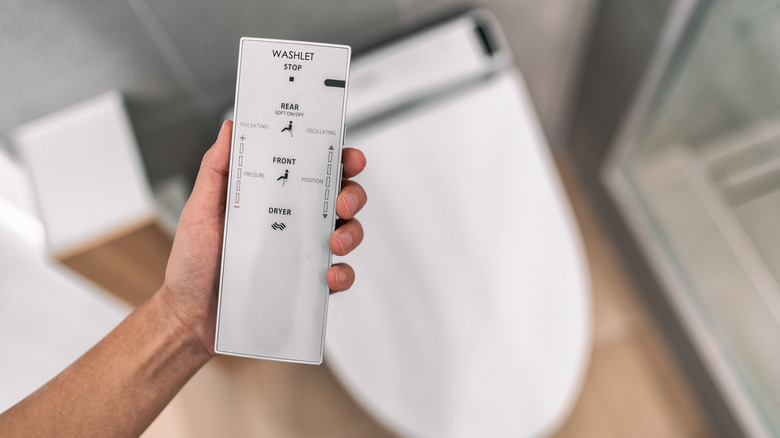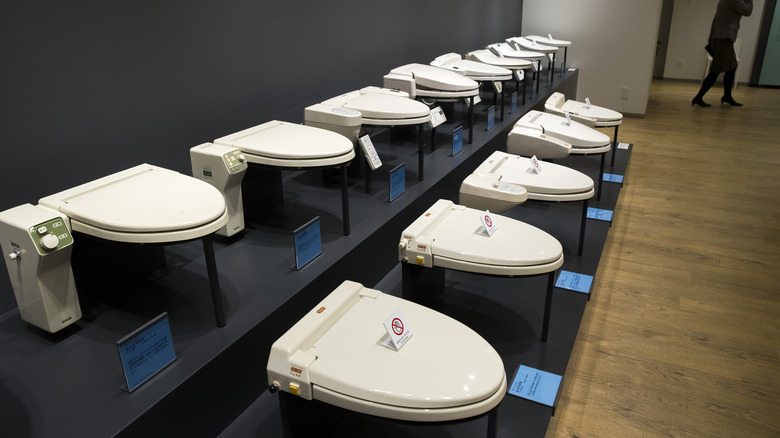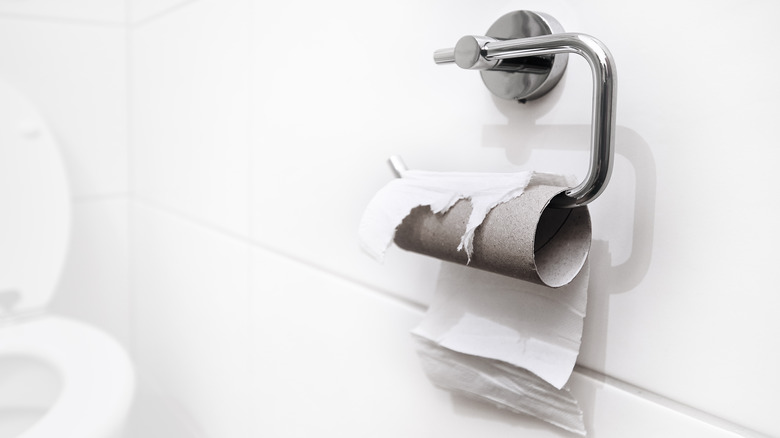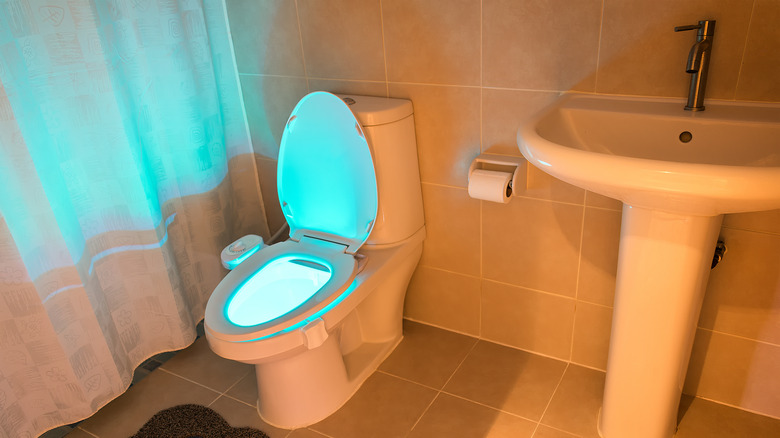How Much Does A Japanese Toilet Cost?
A Japanese toilet, contrary to what its name may suggest, does not necessarily need to be a toilet that was manufactured in Japan. Japanese toilets refer to any kind of toilet with additional bells and whistles beyond the typical, bare-bones functions of most toilets used in the United States and other Western countries. These toilets can be full toilets with an attached base, tank, and flusher, such as the most popular brand of Japanese toilet, the Toto company's Washlet. Or, you can also get access to a lot of the most fun and functional features of these toilets by purchasing a Japanese toilet seat, which you can then install on any typical American toilet. Wirecutter reports that these add-on seats typically start at around $200 and average between $400 and $500, while the full-size toilets start at between $400 and $500.
The sky is really the limit for how much you can spend on some of the fancier models -– one of Toto's top-of-the-line Neorest versions could set you back over $19,000! What could possibly make a toilet cost that much? Let's break down some of the factors and additional costs you can expect when considering upgrading your regular old toilet to a sleek Japanese model.
Factors for cost
Because these toilets have so much going on, there is a wide variety of different factors that can contribute to how much one of these models will cost you. But there is one factor in particular that remains consistent across all Japanese toilets — the bidet. Web Japan describes how, contrary to most American and European toilets, Japanese toilets have bidets within the toilet bowl itself so that a user can remain seated during the whole experience. Bidet.org has a good breakdown of some of the most common features relating to these unique bidets and how much you can expect to pay for each.
Water temperature
Who wants a cold stream of water to shock them in their most private areas? Most Japanese toilet bidets come with the ability to adjust the temperature of the water they will be sending your way. Even the less expensive models, starting at $250, allow the users to set their desired water temperature. However, price differentials can come into play in terms of how the water temperature is achieved. More expensive models come with their own miniature water heater built in, meaning warm water is instantaneous. Cheaper models without this tank system will need to be connected to a pre-existing hot water line, such as the one that routes to your bathroom sink or shower. In addition to the slight delay in water warming, this option may also require extra installation costs.
Multiple bidet streams
The default bidet model produces a single stream of water intended for rinsing off after going number two. But that is not exactly helpful for users who also require a cleanup after going number one -– what is the point of paying for a Japanese toilet bidet if you still need to use toilet paper to wipe off your front? For an additional cost, usually bumping up the overall price to around $400, you can receive a bidet with more than one stream: a wash for the back and a wash for the front, so you can say goodbye to toilet paper forever, not just some of the time (though you'll still need to dry off after that cleansing spurt of water).
Self-cleaning bidet nozzle
As you can imagine, bidets can become pretty ... well, gross. They are right there in the bowl, meaning they are exposed to pretty much everything that comes through, so the thought of wiping down a bidet, particularly getting all up in the nozzle, is not exactly appealing. But your bidet obviously needs to be kept clean because a dirty bidet would defeat its whole purpose, right? The solution to avoiding the bidet cleaning chore: the self-cleaning bidet nozzle. Investing in one of these will likely push the price of your toilet up to around $450.
Other adjustable bidet features
Like with the rest of these toilets, there is pretty much an endless amount of adjustments and upgrades you can make to your bidet. Dropping $400 on your toilet will grant you the ability to program not just the temperature of your bidet's water but also its water pressure, the width of its spray, and even the position of its multiple nozzles –- we all have different body types and needs, after all.
Additional costs
As mentioned above, the sky is really the limit in terms of how much you want to add on to your Japanese toilet experience and how much these additions can cost you. From enhanced hygiene measures to a soundtrack to play while you go, there really is not much these toilets can't do.
Heated seats and a heated air dry system
Heated seats are another example of a quality that is reasonably ubiqituous among Japanese toilets. Bidet.org reports that you can find an add-on toilet seat with a built-in bidet and the capacity for seat warming for just $250. Some options also provide you with an air-dry system to blow warm air onto your skin after you have rinsed off with the bidet, which would entirely eliminate the need for toilet paper for either washing or drying. Given that Yahoo! reports the average American family goes through 409 rolls of toilet paper a year, a heated air dry system could pay for itself pretty quickly in saved toilet paper dollars.
Power saving mode
In its report on the Japanese toilet trend, Los Angeles Times describes the benefits of toilets enabled with power-saving mode. When the toilets have the capacity to collect data on when and how often they are used, they have the ability to warm up (literally, in the case of the seat and the bidet water) during peak times and shut off during slow periods. This process both conserves energy and ensures the user's comfort. Bidet.org lists toilets with this feature on the lower end of the pricing spectrum, around $250.
Oscillating, pulsing, and turbo wash
For $400, Bidet.org reports that you can further customize the stream options for your Japanese toilet's bidet. With an oscillating wash, the spray can move back and forth and side to side, allowing the user to receive a more targeted stream without widening the width of the stream itself, which saves water and reduces unwanted splashing. A pulsing wash is just what it sounds like: a "pulse" of water, which is considered particularly helpful for cleaning up solid waste. And the turbo wash is essentially a water massage, which can be beneficial for those with issues that complicate their ability to have bowel movements, such as hemorrhoids or constipation (although, it should be noted that the turbo wash feature is not intended to replace an enema prescribed by a doctor).
Air deodorizing
You know the feeling when you try to cover up a bad smell with an air freshener spray, and you can still smell the bad smell underneath the flowers and sunshine? You can say goodbye to bathroom stink embarrassment forever with the air deodorizers built into some Japanese toilets, available for around $450, according to Bidet.org. These deodorizers work not by spraying some fruity scent into the air to mask the bad smell but rather by vacuuming up the stinky air itself through a built-in fan system. Plus, this process is more healthy than spraying an air freshener, which can have detrimental effects on your home's indoor air quality, according to a 2016 study published in the journal Air Quality, Atmosphere, & Health.
Cleaning capabilities
You already know that you might be able to get out of cleaning your Japanese toilet's bidet, but what if you never had to clean your toilet at all, ever again? For $363, you could buy a Toto toilet with its patented CEFIONTECT ceramic glaze, which prevents anything from sticking to the toilet's bowl and needing to be scrubbed off. Toto also boasts further innovations in self-cleaning technology, including a model for $600 that adds a tiny amount of soap to the bowl's water before use and, for $1000, a model that rinses the toilet bowl both before and after use, again to prevent anything from sticking.
Automation
You may already be familiar with toilets that automatically flush once they determine a user has stood up, but did you know toilets can also automatically lift their lids when they sense a user approaching? Some Japanese toilets, such as Toto's top-of-the-line Neorest, also install proximity sensors on the bidets so that the stream will automatically cease when a user is finished. This kind of automation is not only cool and futuristic – it is also good hygiene to touch as little of your toilet as possible, so there are health benefits associated with this upgrade as well. A toilet with an automated lid and bidet shut-off runs for around $2000.
Lighting
If you really want to go the extra mile in toilet luxury, you can upgrade your Japanese toilet to feature LED lighting. Never again will you have to squint your eyes against the sudden onslaught of a bright bathroom light in the middle of the night – or worse, grope around in the dark for what could be the toilet but could also be the trash can. Adding a soft LED glow to your futuristic toilet is one of the pricier upgrades, though: a Toto toilet tricked out with night lights can cost you up to $11,000.
The whole bathroom aesthetic
If a Japanese toilet is just part of a complete bathroom upgrade for you, you may be able to find toilets with bells and whistles not available on solo units, only on toilets that come as part of a bathroom-wide package. INAX, another toilet company based in Japan, offers the S400 and S600 toilet series, with a number of flashy features not seen elsewhere.
These include the shower wash, which could be described as the exact opposite of the turbo wash mentioned above: a softer stream made by mixing water with air, specifically designed for a more gentle front cleanse. The INAX S600 also includes a "foam cushion," a fine foam particulate automatically added to the toilet bowl after each flush to prevent splashing and reduce required cleaning.
If you really want to get wild with your toilet aesthetic, who says toilets can only be white? The S600 offers the option of a sleek matte black. But, as said above, these toilets are only available as part of a bathroom-wide upgrade, with prices not even listed on their brochures – the classic "you have to ask how much it costs" tactic. You can probably safely assume the fancier features will cost you a pretty penny.
Installation
Don't forget that, beyond the cost of the toilet itself, you will also need to pay to have it installed in your bathroom. The famous bidets, along with many other aspects of Japanese toilet wizardry, require electricity to operate, but, as the Taipei Times notes, most American bathrooms do not have an electrical outlet located near the toilet. If you want to go with the less expensive option of adding a bidet-enabled seat to your otherwise American toilet, HomeServe reports that cost of bringing in an electrician to hardwire an outlet for your new toilet seat will probably run you around $500. If you're going with the full toilet with all the fancy features, though, installing an entirely new toilet in your bathroom will cost you closer to $1000.
Types of Japanese toilets
As just mentioned, Japanese toilets are broken down into two separate types: the add-on toilet seats, with bidets and potentially other fun attributes that you can attach to your current toilet, and the full, complete toilet that will replace your existing American model.
Japanese toilet seats
If you choose to go with the add-on seat option, never fear –- you can still experience many of the bells and whistles that come with the Japanese toilet experience. Wirecutter reports that all Japanese toilet seats come with the famous bidets, many of which also feature the associated bidet features and adjustments, such as the ability to set your water temperature preference, the self-cleaning feature, etc. Many of these seats are also heated, and a few include the blow-drying and remote control options usually only found with the full models.
Full Japanese toilets
Of course, there are a few attributes you can only experience with the full Japanese toilet models. These toilets, which Travel2Next reports are usually referred to in Japanese as "takino toire" ("multifunction toilet"), can have all the bells and whistles referred to above: an embedded hot water tank for a quick-heating bidet stream, air deodorizing, power saving mode, automatic seat lifting, advanced cleaning options, and, of course, the LED night light.
Why You Need a Japanese Toilet
In case all of the futuristic features described above still have not convinced you why you should invest in a Japanese toilet, here is a list of some additional reasons why you should take the plunge, so to speak.
Freedom from the supply chain
Remember the beginning of the coronavirus pandemic? What was the number one hot commodity that no one could find anywhere? That's right: toilet paper. A month into the pandemic, almost half of all grocery stores in the United States were completely out of toilet paper, according to NC State University. And don't think that a toilet paper shortage couldn't happen again -– that same article points out that grocery stores typically keep only a week's worth of toilet paper on hand in their warehouses, so the system is pretty much always vulnerable to any supply chain disruption, including panic-buying and hoarding.
But guess who doesn't have to worry about whether or not they can find toilet paper in the grocery store? People who own Japanese toilets! If you have a model that includes both the bidet wash and the air-drying feature, you will hypothetically never need to purchase toilet paper again. Cross "worrying about TP availability" off your list forever.
Cost savings
After reading about all the extra costs associated with these toilets, the last thing you may be thinking is that a Japanese toilet could end up actually saving you money. But it's true, these toilets do eventually pay for themselves. And once again, it all comes down to toilet paper. As mentioned above, the average American household goes through 409 rolls of toilet paper per year, which translates into approximately $123 per year, per Statista. $123, spent just on toilet paper! Based on that statistic, after just two years, the cheapest Japanese toilet models will already be saving you money.
Resale value
Toilets with integrated bidets exploded in popularity in 2020, and their shine has not worn off since. The Washington Post reports that bidet sales shot up 3000% since early 2020, and interest remains high even after the pandemic spike mellowed out. Installing a Japanese toilet in your home may very well be something that sways a prospective buyer's mind when your home is on the market.
Benefits of Japanese Toilets
Beyond the economic advantages of a Japanese toilet, there are a number of other positive benefits. Japanese toilets can improve your life in a variety of ways, some of which may surprise you.
Health benefits
Believe it or not, the toilet system you use can have a direct impact on your health. According to the same article in The Washington Post that analyzed bidet sales, Americans could benefit from switching from a system of wiping to a system of washing. Americans have a predisposition to wipe themselves a little too thoroughly, which can cause skin irritation and even tiny cuts in an area that is already pretty sensitive. Integrated bidets are also helpful for people who may be experiencing mobility issues, such as those with Parkinson's disease or arthritis, or for people with spinal cord injuries who may have decreased sensation in the lower half of their body. Wiping isn't always the best option if you struggle to reach that area or you can't feel exactly what you're doing, so bidets can be quite beneficial in these situations.
A number of scientific studies have examined the relationship between bidets and healthy hygiene, with promising results. A 2005 study published in The Gerontologist journal found that Japanese toilets featuring bidets with both washing and drying capabilities, entirely eliminating the need for wiping, improved nursing home residents' comfort around toilet hygiene. Another study, published in 2011 in the Journal of Korean Medical Science, found the use of Japanese toilets had potential health benefits for people experiencing hemorrhoids. Who knew that a simple switch to a bidet could have so many positive ramifications?
Environmental benefits
Not only can Japanese toilets make you healthier, they can make the planet healthier as well. Again, it all goes back to toilet paper. According to Scientific American, Americans alone consume around 37 billion rolls of toilet paper per year, taking out approximately 15 million trees in the process. And that's just for the end product, the paper itself. The process of manufacturing toilet paper also consumes vast amounts of resources: 474 billion gallons of water, 253,000 tons of chlorine (used for bleaching the paper white), and 17.3 terawatts of electricity -– the same amount needed to light two trillion LED lightbulbs. Switching over to a Japanese toilet and its bidet could save Mother Earth a whole lot of heartache.
Comfort and fun
Beyond the benefits to your health and the environment, Japanese toilets are just so cool. Even if you have limited funds and invest in a less fancy model, you're still going to experience a massive upgrade from your current toilet situation. Japanese toilets are catching on so fast that TopHotelNews reports more and more hotels are considering installing Japanese-style toilets in their bathrooms. If given the opportunity, who wouldn't want a toilet that keeps their booty warm, lifts the seat when they approach and glows in the dark? And that's just the beginning -– who knows what is next for the future of Japanese toilet technology.
